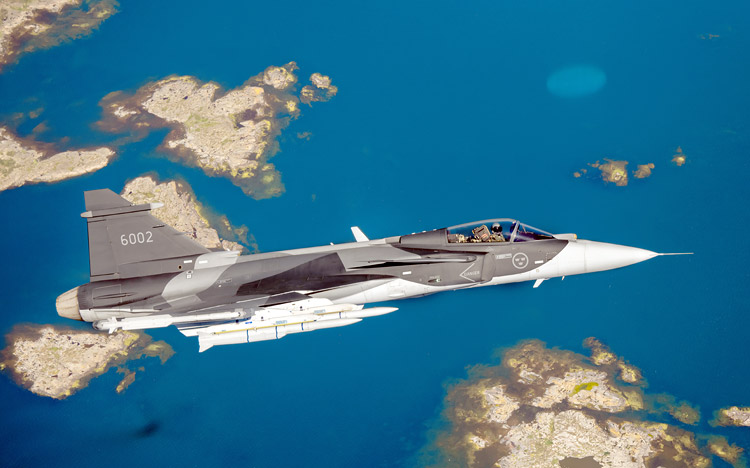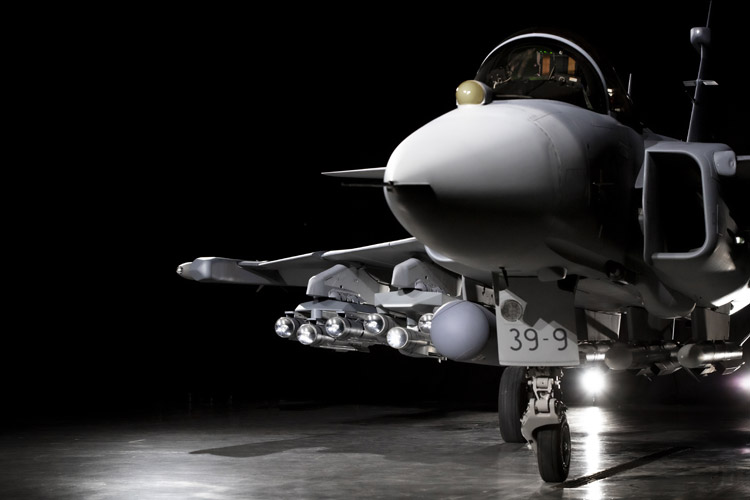INDIAN ARMED FORCES CHIEFS ON
OUR RELENTLESS AND FOCUSED PUBLISHING EFFORTS

SP Guide Publications puts forth a well compiled articulation of issues, pursuits and accomplishments of the Indian Army, over the years

I am confident that SP Guide Publications would continue to inform, inspire and influence.

My compliments to SP Guide Publications for informative and credible reportage on contemporary aerospace issues over the past six decades.
- Prime Minister witnesses 'Bharat Shakti' – a Tri-Services Firing and Manoeuvre Exercise in Pokhran, Rajasthan
- Interim Defence Budget 2024-25 — An Analysis
- Union Defence budget 2024
- Prime Minister Modi Commemorates Indian Navy Day in a Grand Ceremony
- Prime Minister Modi Flies in the LCA Tejas
- New Chapter in India-Italy Defence Ties
- Airpower beyond Boundaries
Saab unleashes aggressive offers of Gripen for India
Price war unleashed ahead of MRFA competition, pitting Euro 125 million Gripen against Euro 216 million Rafale

Sweden’s Saab group made a bold, pre-tender pitch for an Indian order for 114 fighter aircraft by declaring that its Gripen single-engine fighter is on offer for “half the price India has paid for the Rafale”. Saab expects India to launch a global tender in the “first half of next year”.
The Rafale is a larger, twin-engine aircraft and thus more expensive but Saab is pitching its single-engine aircraft as a dramatically cheaper solution for the same role.
To illustrate its claim on a massive price advantage, Saab disclosed its price bid for an ongoing tender for 64 fighter aircraft for Finland, also known as the HX Fighter programme.
In an online media briefing, Magnus Skogberg, Gripen Campaign Director for Finland revealed that the price offered for 64 Gripen E fighters is Euro 6.5 billion, which includes the cost of a sustainment package for a decade as well as transfer of technology to Finland. The weapons package has been offered for an additional Euro 1.5 billion.
To illustrate its claim on a massive price advantage, Saab disclosed its price bid for an ongoing tender for 64 fighter aircraft for Finland, also known as the HX Fighter programme
This weapons package is similar in capability to the one India has acquired in the Euro 7.8 billion deal for 36 Rafale fighters. It includes the Meteor, IRIS-T, KEPD-350 Taurus and the Spear.
The Finland tender also involves the procurement of two Airborne Early Warning and Control (AEW&C) aircraft along with 64 fighters. Saab has offered two Global Eye platforms at an additional Euro 1.0 billion.
Skogberg expects the Finnish competition to be concluded and the winner announced next month.

India paid an estimated price of Euro 216.7 million (1,820.9 crore) a piece for the Rafale in the 2016 deal. Without the weapons package the cost was Euro 194.4 million (1,633.5 crore). The current Gripen price, as disclosed by Skogberg, is Euro 125 million (1,050.4 crore) with the weapons package and Euro 101.6 million (853.7 crore) for the bare aircraft. In comparison, the contracted price of the indigenous Light Combat Aircraft (LCA) Mk 1A is 578.3 crore for the bare aircraft.
In 2012, the French Rafale was declared the winner of India’s elaborate competition to purchase 126 Medium Multi-Role Combat Aircraft (MMRCA). The Gripen was one of the contenders in that tender. At that time, it could not meet the technical requirements of the IAF. From a field of six competing fighters in what was billed as the ‘Mother of all Competitions’, only the Rafale and the Eurofighter were adjudged technically compliant by the IAF. Both the Rafale and the Eurofighter are twin-engined fighters.
India paid an estimated price of Euro 216.7 million (1,820.9 crore) a piece for the Rafale in the 2016 deal. Without the weapons package the cost was Euro 194.4 million (1,633.5 crore). The current Gripen price, as disclosed by Skogberg, is Euro 125 million (1,050.4 crore) with the weapons package and Euro 101.6 million (853.7 crore) for the bare aircraft. In comparison, the contracted price of the indigenous Light Combat Aircraft (LCA) Mk 1A is 578.3 crore for the bare aircraft
The tender was aborted in 2015 reportedly over an impasse in contractual negotiations between Dassault of France and HAL for manufacturing 108 of the 126 fighters in India as per the terms of the tender. But India stuck by the IAF’s 2012 choice of the Rafale in making a stand-alone, emergency purchase of 36 Rafale fighters in 2016 for Euro 7.8 billion off the shelf to bolster its sharply depleting airpower.
The Rafale procurement and commitment to the LCA and the futuristic AMCA not with standing, the IAF’s requirement for six squadrons of a foreign jet persists. Given limitations of local manufacturing capability, acquiring six squadrons of a foreign jet is essential to the IAF’s plans to take its fighter aircraft strength to a minimalistic 35 squadrons by 2035. Its actual requirement is pegged much higher at 42 squadrons.
The Multi-Role Fighter Aircraft (MRFA) programme to acquire 114 foreign jets through transfer of technology under the ambitious Strategic Partnership model has to be seen in this context. The MRFA is poised to be a re-run of the abortive MMRCA. This time around, Saab claims to have overcome the deficiencies because of which it was technically relegated a decade earlier.
Saab is now extrapolating the figures in Finland’s HX Fighter Programme to India’s emerging competition - where the stakes are much higher- to provide contemporary comparisons. “We expect the RFP to be out in the first half of next year,” Mats Palmberg, Head of Gripen India Campaign, said.
Saab has assured a minimum availability or serviceability rate of 78 per cent. “Over 50 of the 64 (offered to Finland) will always be available (to fly),” Skogberg said, disclosing further details about its offer to Finland
Saab is aggressively pitching its economy trumpcard and seeks to make theMRFA competition about reliability at low cost. “The Gripen offer ensures twice the number of fighters airborne at half the cost,” Skogberg boasted, claiming a winning combination of low price and high serviceability. In its bid for the HX Fighter Programme, Saab has assured a minimum availability or serviceability rate of 78 per cent. “Over 50 of the 64 (offered to Finland) will always be available (to fly),” Skogberg said, disclosing further details about its offer to Finland.
He extended his economy pitch to operating costs.“The annual operational cost of the 64 Gripensto Finland will be under Euro 250 million,” the Saab honcho said. Theoffer by Saab requires the customer to commit an additional Euro 2.0billion for upgrading the fighter over its 40-year life cycle.
Palmberg, who seeks to pitch an offer to India which mirrors the one made to Finland, rejects the view that the IAF’s commitment to the indigenous LCA - which seemed tentative a few years ago – will kill the market for foreign single-engine fighters like the Gripen and the F-16/F-21. “There’s room for more single-engine fighters,” the India Campaign head said, expressing hope that costs of acquisition and flying would not only keep the single-engines in contention but also be the winning card this time.
“There are two parts to our offer: Security of supply and the offer to help develop future fighters for India,” Palmberg said, responding to questions by this reporter. “We’ve offered help on a broad set of technologies,” he said, without elaborating the contours of the offer to assist India, which currently has the LCA Mk-II and the fifth generation Advanced Medium Combat Aircraft (AMCA) on the drawing board.





